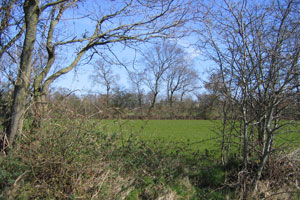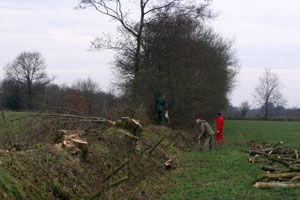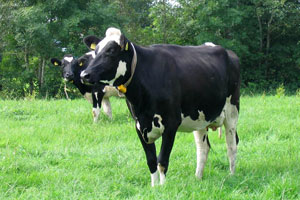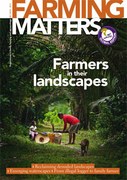Charming as it may seem, the landscape of the Northern Frisian woodlands in the Netherlands would have looked very different today if dairy farmers had not organised themselves in territorial cooperatives and forged alliances to challenge policies, laws, and the dominant view on farming and nature management.

Friesland, in the north of the Netherlands, is a region with a strong cultural identity and its own language. In it lies the Northern Frisian woodlands, a diverse area covering 50,000 hectares. Beside the woodlands, small fields surrounded by hedgerows and belts of alder trees (Alnus spp.) further characterise the local landscape.
For generations, this has been maintained by the collective work of farming families. It stands in stark contrast with many of the monotone farming landscapes seen elsewhere in the Netherlands – the product of decades of government promoted agricultural industrialisation and scale enlargement.
These policies are one of the reasons why the Netherlands has become the second largest net exporter of agricultural produce in the world (in money terms), but this has had its down side. It has been associated with vulnerability for large scale outbreaks of animal diseases and increasing pollution. It has also led to land grabbing and deforestation elsewhere in the world as it relies heavily on imported soybeans and other animal feeds. Rather than seeing these as expressions of a deeper underlying crisis in agriculture and food, the Dutch government has responded with a series of policy measures directed only at symptomatic relief. But these measures are not always in tune with the priorities of Dutch farmers. They provoked resistance amongst dairy farmers in the Northern Frisian Woodlands, and marked the beginning of a long-lasting struggle for autonomy and sustainable production.
Their initiative brought together farmers, civil society, entrepreneurs, research institutes and the government itself in developing new values. The result has been not just the preservation of the unique landscape, but also greater sustainability and improved profitability of local farms.
Trapped in a landscape
Governmental policy measures in the 1980s to tackle the effects of acid rain and nitrogen leaching on nature reserves were highly prescriptive. Hedgerows were for instance declared acid sensitive and severe limitations were put on agricultural activities nearby. Farmers were literally trapped in the dense hedgerow landscape they have positively managed for generations.
“We cherish the landscape, it is part of our identity.”
In addition, farmers were no longer allowed to spread manure on the land as they always had done, but had to inject it into the soil. Farmers felt they were being treated unjustly, and the new rules and regulations threatened the continuity of many farms.
The farmers knew that they could combine nature conservation and maintain farms and landscape if they were allowed to do it in their own way. Some farmers were considering removing hedges before the rules came into force, others negotiated and convinced municipal and provincial authorities to have the hedgerows exempted. In exchange, farmers promised to maintain and protect the hedges, ponds, alder rows and sandy roads in the area. This gave rise to the first two territorial cooperatives in the Netherlands, the Eastermars Lânsdouwe and the Vereniging Agragrisch Natuur en Landschapsonderhoud Achtkarspelen. Four other organisations were formed soon afterwards, and in 2002, the overarching Noardlike Fryske Wâlden (Northern Frisian Woodlands, NFW) cooperative was founded, with a membership of more than 1000 farmers as well as private individuals, including almost 80% of all farmers in the area.
Bringing farming into nature, and vice versa

Farmers strengthened their way of dairy farming by integrating nature and landscape elements in their farming practices.
Environmental conservation has traditionally been the role of nature organisations, so farmers needed to gain support from other farmers and local government before they could begin to actively manage the landscape ‘for nature’. The NFW was able to convince and align with civil society organisations, especially nature organisations, and set two trajectories in motion. One focused on maintaining and improving the landscape and nature, and the other on developing a path for sustainable farming.
To overcome the new legislative barriers, the cooperative negotiated with the government and developed a detailed ecological and landscape management plan. They convinced the officials and were able to obtain exemptions from several asphyxiating regulatory schemes.
The result was that farmers are now managing about 80% of the natural and other landscape elements in their area. This includes not only more than 300 km of hedgerows, but also 3800 km of alder wooded bank rows, 400 ponds, 7500 hectares of collectively protected areas to support meadow birds and 4000 hectares for geese. Cooperative activities resulted in improvements for the whole region and far beyond the participating farms, including the strengthening of the rural economy, improved product qualities and more trust and cooperation between farmers and other residents. The government recognised the uniqueness of the Northern Frisian Woodlands, which they recently declared a national landscape. The biodiversity has grown richer, and the attractive landscapes are opening up new opportunities for rural tourism and recreation which are taken up by the cooperative by for example by restoring ancient sandy paths as walking trials or cycle tracks.
Although farmers were somewhat familiar with this way of managing the land, they also learned much and strengthened their way of dairy farming by integrating nature and landscape elements in their farming practices. In the words of one farmer: “If you manage the landscape well, biodiversity increases. You get for instance more grass species, which positively affects the cows’ health. And careful maintenance of the tree belts attracts more birds. They eat the insects that destroy the roots of the clumps of grass. So the more birds there are, the less insecticide you need. Nature and landscape management is thus economically advantageous. That is what I learned in the course of time.”
The economic benefits are all the more important as although farmers receive some compensation from EU and the government for about half the area under landscape management, this hardly pays for the time they spend on these activities. Most of the subsidies that are available for nature conservation continue to be allocated to environmental organisations, and farmer-managed landscapes still tend to be taboo among policy makers and within mainstream farmer organisations.
Better manure, less fertilizers
A government regulation obliging farmers to inject slurry into the soil triggered the second trajectory. The reasoning was that slurry or manure applied on the surface more easily washes away to pollute the environment. It also releases ammonia, which causes acidification and nitrogen pollution that can be especially harmful in protected areas. But farmers were sceptical. With small field and high groundwater levels in the spring, their land was not suited to the heavy machinery needed for slurry injection. The nutrients would also be lost into the groundwater so requiring ever more fertilizer to maintain yields. Farmers argued that injecting slurry would kill soil life, and that they could improve the situation by producing better quality manure.
Negotiations with the government on this point were equally successful and resulted in a temporary exemption from the rules in 1995, based on an ‘experiment’. The cooperative agreed with the government that they would actively explore alternative ways to reduce nitrogen leaching. But due to political changes in 1998, the cooperative could only maintain the exemption if the experiment became ‘scientific research’. This resulted in the nutrient management project including 60 farmers and scientists of various disciplines.
As a result of this experiment, an unconventional perspective in developing new practices was developed, called kringlooplandbouw or ‘closed-loop farming’ based on natural cycles. This improved nitrogen efficiency on the farm and landscape level. Manure improvement was the starting point, with farmers giving their cattle more fibrous feeds such as grass and less protein such as soybean concentrates. Straw and microbial additives were also mixed with the manure. This produced more solid and higher quality manure resulting in less nitrogen losses to the environment. Special muck-spreaders were also developed that were suitable for small fields. Farmers also reduced the use of chemical fertilizers, but as there were improvements in soil biology, grass yields even increased. Healthier cattle, higher milk quality and better manure were the result, thereby completing the cycle.
Today, this approach has spread, with many experts and farmers coming to the Northern Frisian Woodlands to learn, the cooperative has taken up an educational role and regularly organises guided tours and presentations.
Learning in ‘field laboratories’

These Frisian farmers continue to develop new practices, using their own as well as external resources. New knowledge is gained and disseminated through a wide range of methods, including nature conservation and landscape management courses, and excursions to other farms in and outside the region.
Less conventional methods of learning by doing are often combined with small study groups where experiences are exchanged, where farmers discuss their successes and failures.
Another innovative method is farmer-led scientific research. Farmers raise the questions, the research is carried out on their own farms, and results are discussed between farmers and scientists as well as within the communities.
Much of what is learnt in these ‘field laboratories’ builds on traditional knowledge. Regional characteristics such as hedgerows and alder trees have always been a self-evident part of the farm. Knowledge about local crops and cattle breeds has also passed down through the generations as a base for local agrobiodiversity. The territorial cooperative takes advantage of this wealth of knowledge and also created a system to spread it further among other farmers.
A landscape of possibilities
Farmers in the Northern Frisian Woodlands have shown that together with others, they can achieve both sustainable farming systems and environmental and nature policies objectives, by integrating landscape management into their daily activities. This forms part of a novel strategy of reducing costs, and improving own resources such as manure and grassland. “The general feeling is that the costs for fertilizer and fodder have decreased substantially. We have also become more innovative; we now dare to follow pathways that are not yet advocated by experts,” says one participating farmer.
By building alliances with civil society organisations and researchers, and by lobbying and negotiation, farmers have shown how they are able to deviate from imposed, top-down regulations, and to experiment themselves. They made the room needed to search for locally adapted and tailor made solutions, but which also materialised into a new self-organised form of landscape governance. The different way in which the cooperative has been able to connect with local, regional and national authorities clearly shows the potential for farmers to exert political influence at all these levels. The internal organisation developed over the past 25 years and the extended network with NGOs and government at all levels, has given the territorial cooperative considerable strength, and it can deliver where others fail. The level of participation is very high, very much strengthening social capital as it has developed.
The Dutch Ministry of Agriculture invited the NFW and four other cooperatives to test new methodologies. Since the territorial cooperatives had convincingly proven their capacity for self-regulation, they were more that able than other institutions, and many of their proposals are now integrated in official policy. It shows that by taking the lead, the position of farmers in today’s societies can be greatly strengthened.
Since 2003, the NFW has worked on other aspects of the regional economy and its sustainability, such as green energy, improving product quality, animal welfare, and cost reduction strategies. A territorial contract was then created together with stakeholders in the area and signed by parties including the provincial government, ministries and academic institutions. Although the NFW continue to swim against the tide, now that farmers have taken their landscape back into their own hands, they know that everything is possible.
Sabine de Rooij, Leonardo van den Berg and Douwe Hoogland
Sabine de Rooij (sabinederooij@gmail.com) is independent researcher in rural development issues.
Leonardo van den Berg (l.vandenberg@ileia.org) is Research Officer for ILEIA, the Netherlands.
Douwe Hoogland is the chair of the Northern Frisian Woodlands cooperative.
This article draws on the work of NFW (2014), de Rooij (2010), and van der Ploeg (2008).

